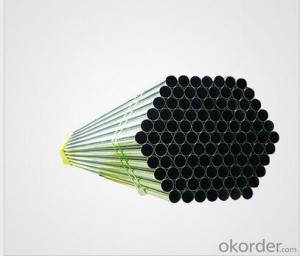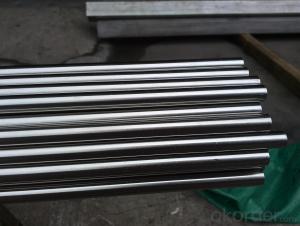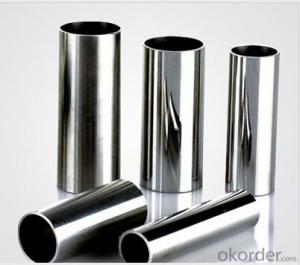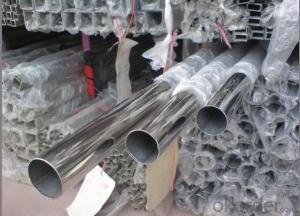Stainless Steel Welded Pipe ASTM A249/A269; GB/T24593
- Loading Port:
- Ningbo
- Payment Terms:
- TT OR LC
- Min Order Qty:
- 25 m.t.
- Supply Capability:
- 5000 m.t./month
OKorder Service Pledge
OKorder Financial Service
You Might Also Like
1、Structure of Stainless Steel Welded Pipe ASTM A249/A269; GB/T24593:
Stainless steel Welded pipe is used in applications that require the pipe to have high anti-corrosive properties. Compared to steel and cast iron pipes, stainless steels are more flexible, durable and have a higher strength. They are very resistant to erosion-corrosion and can be formed and welded into various shapes and sizes. It is easily connected with various other piping systems and materials and is designed to withstand long life cycles.2、Main Features of Stainless Steel Welded Pipe ASTM A249/A269; GB/T24593:
• High manufacturing accuracy
• High strength
• Small inertia resistance
• Good visual effect
•Reasonable price
3、 Stainless Steel Welded Pipe ASTM A249/A269; GB/T24593 images:


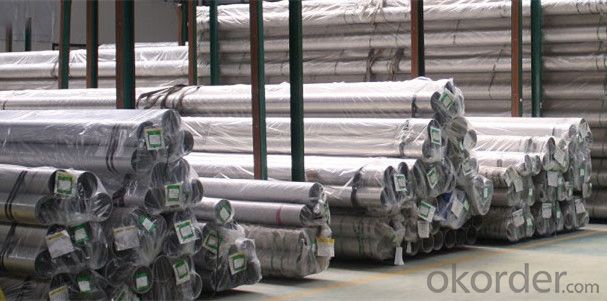
4、 Stainless Steel Welded Pipe ASTM A249/A269; GB/T24593 Specification:
Size:
| DN | OD | WT | ||||
| SCH 5S | SCH 10S | SCH 20S | SCH 40S | |||
| (A) | (B) | mm | mm | mm | mm | mm |
| 350 | 14' | 355.6 | 3.96 | 4.78 | 7.92 | 11.13 |
| 400 | 16' | 406.4 | 4.19 | 4.78 | 7.92 | 12.7 |
| 450 | 18' | 457.2 | 4.19 | 4.78 | 7.92 | 14.27 |
| 500 | 20' | 508.0 | 4.78 | 5.54 | 9.53 | 15.09 |
| 550 | 22' | 558.8 | 4.78 | 5.54 | 9.53 | 15.09 |
| 600 | 24' | 609.6 | 5.54 | 6.35 | 9.53 | 17.48 |
| 650 | 26' | 660.4 | 5.54 | 7.92 | 12.7 | 17.48 |
| 700 | 28' | 711.2 | 5.54 | 7.92 | 12.7 | 17.48 |
| 750 | 30' | 762.0 | 6.35 | 7.92 | 12.7 | 17.48 |
| 800 | 32' | 812.8 | 7.90 | 12.7 | 17.48 | |
| 850 | 34 | 863.6 | 7.92 | 12.7 | 17.48 | |
| 900 | 36' | 914.4 | 7.92 | 12.7 | 19.05 | |
| 1000 | 40' | 1016.0 | 9.53 | |||
| OD(mm) | WT(mm) | |||||||||||||
| 0.5 | 0.6 | 0.7 | 0.8 | 0.9 | 1 | 1.2 | 1.5 | 2 | 2.5 | 3 | 4 | 5 | ||
| 9.5 | ||||||||||||||
| 12 | ||||||||||||||
| 1/2' | 12.7 | |||||||||||||
| 13 | ||||||||||||||
| 14 | ||||||||||||||
| 5/8' | 15.9 | |||||||||||||
| 3/4' | 19.1 | |||||||||||||
| 7/8' | 22.2 | |||||||||||||
| 1' | 25.4 | |||||||||||||
| 1-1/8' | 28.6 | |||||||||||||
| 1-1/4' | 31.8 | |||||||||||||
| 1-1/2' | 38.1 | |||||||||||||
| 40 | ||||||||||||||
| 45 | ||||||||||||||
| 2' | 50.8 | |||||||||||||
| 52 | ||||||||||||||
| 2-1/4' | 57.15 | |||||||||||||
| 2-3/8' | 60.3 | |||||||||||||
| 2-1/2' | 63.5 | |||||||||||||
| 70 | ||||||||||||||
| 3' | 76.2 | |||||||||||||
| 85 | ||||||||||||||
| 3-1/2' | 88.9 | |||||||||||||
| 4' | 101.6 | |||||||||||||
| 4-1/8' | 104.78 | |||||||||||||
| 4-1/4' | 107.95 | |||||||||||||
| 4-1/2' | 114.3 | |||||||||||||
| 5-1/4' | 133.35 | |||||||||||||
| 6-1/4' | 158.75 | |||||||||||||
| 8-5/8' | 219.08 | |||||||||||||
ASTM A249 tolerance:
| OD | WT | Length | |
| <25.40mm | ±0.10mm | ±10.00% | OD<50.8mm +3.0mm -0mm OD≥50.8mm +5.0 -0mm |
| ≥25.4mm~38.1mm | ±0.15mm | ||
| ≥38.1mm~50.8mm | ±0.20mm | ||
| ≥50.8mm~63.5mm | ±0.25mm | ||
| ≥63.5mm~76.2mm | ±0.30mm | ||
| ≥76.2mm~101.6mm | ±0.38mm | ||
| ≥101.6mm~190.5mm | +0.38mm -0.64mm | ||
| ≥190.5mm~228.6mm | +0.38mm -1.14mm | ||
ASTM A269 tolerance:
| OD | WT | Length | |
| <38.1mm | ±0.13mm | OD<12.7mm ±15% OD≥12.7mm ±10% | OD<38.1mm +3.20mm -0mm OD≥38.1mm +4.80 -0mm |
| ≥38.1mm~88.9mm | ±0.25mm | ||
| ≥88.9mm~139.7mm | ±0.38mm | ||
| ≥139.7mm~203.7mm | ±0.76mm | ||
| ≥203.7mm~304.8mm | ±1.01mm | ||
| ≥304.8mm~355.6mm | ±1.26mm | ||
5、FAQ of Stainless Steel Welded Pipe ASTM A249/A269; GB/T24593:
①How is the quality of your products?
Our products are manufactured strictly according to national and internaional standard, and we take a test on every pipe before delivered out. If you want see our quality certifications and all kinds of testing report, please just ask us for it.
Guaranteed: If products’ quality don’t accord to discription as we give or the promise before you place order, we promise 100% refund.
②How about price?
Yes, we are factory and be able to give you lowest price below market one, and we have a policy that “ for saving time and absolutely honest business attitude, we quote as lowest as possible for any customer, and discount can be given according to quantity”,if you like bargain and factory price is not low enough as you think, just don’t waste your time.Please trust the quotation we would give you, it is professional one.
③Why should you chose us?
Chose happens because of quality, then price, We can give you both.Additionally, we can also offer professional products inquiry, products knowledge train(for agents), smooth goods delivery, exellent customer solution proposals.Our service formula: good quality+good price+good service=customer’s trust
SGS test is available, customer inspection before shipping is welcome, third party inspection is no problem.
Any question, pls feel free to contact us !
- Q: What brand of stainless steel pipe cutting machine is good?
- Stainless steel cutting pipe should take into account the cutting speed, accuracy, cross section flatness, surface scratches, cutting tool loss and so on
- Q: Can stainless steel pipes be insulated with polycaprolactone?
- Yes, stainless steel pipes can be insulated with polycaprolactone. Polycaprolactone is a versatile and flexible thermoplastic material that can be used for insulation purposes. It can provide effective thermal insulation to stainless steel pipes and help in reducing heat transfer and preventing condensation.
- Q: Can stainless steel pipes be used for gas applications?
- Yes, stainless steel pipes can be used for gas applications. Stainless steel pipes are known for their high strength, corrosion resistance, and durability, making them suitable for various industrial applications, including gas transportation.
- Q: How do stainless steel pipes compare to ductile iron pipes?
- Stainless steel pipes and ductile iron pipes have different characteristics and applications. Stainless steel pipes offer excellent corrosion resistance, making them suitable for various industries, including food processing and chemical plants. On the other hand, ductile iron pipes are known for their strength and durability, making them commonly used in water distribution systems and sewer lines. Ultimately, the choice between stainless steel and ductile iron pipes depends on the specific needs and requirements of the project or application.
- Q: What is the average weight of a stainless steel pipe?
- The weight of a stainless steel pipe can differ based on its size, wall thickness, and length. Various dimensions and grades are accessible for stainless steel pipes, which can impact their weight. However, in general, stainless steel pipes are typically heavier compared to pipes made from alternative materials due to the density of stainless steel. The weight of a stainless steel pipe can range from a few kilograms to several hundred kilograms per meter, depending on the factors mentioned earlier. To accurately determine the exact weight of a stainless steel pipe for a specific application, it is crucial to refer to the product specifications or consult a supplier.
- Q: What are the factors to consider when selecting stainless steel pipes for a specific application?
- To ensure the right choice of stainless steel pipes for a specific application, several factors must be taken into consideration. 1. Corrosion Resistance: Stainless steel is widely known for its exceptional resistance to corrosion. However, it is important to assess the specific corrosive agents present in the application, such as chemicals, moisture, or high temperatures. By evaluating these agents, one can select a stainless steel grade that effectively withstands them. 2. Temperature and Pressure: Stainless steel pipes are used in various temperature and pressure conditions. The selected grade should possess the necessary strength and resistance to handle the specific levels required by the application. Higher temperatures might call for grades with increased heat resistance, while high-pressure environments may benefit from pipes with higher tensile strength. 3. Material Compatibility: In certain applications, stainless steel pipes come into contact with other materials or substances, such as liquids or gases. It is crucial to consider the compatibility of the stainless steel with these materials to avoid potential chemical reactions, contamination, or degradation. Conducting compatibility testing or seeking expert advice can help determine the best material choice. 4. Size and Dimensions: The size and dimensions of the stainless steel pipes must align with the application's requirements. This involves considering the diameter, thickness, and length of the pipes. Proper sizing guarantees optimal flow rates, structural integrity, and ease of installation. 5. Cost: Cost is an important factor in decision-making. Different stainless steel grades have varying prices, so it is necessary to strike a balance between desired properties and the allocated budget. While cost should not be the sole determining factor, it is important to find a stainless steel pipe that meets specifications without exceeding the budget. 6. Standards and Certifications: Depending on the application, specific standards and certifications, such as ASTM, ASME, or ISO, may be required. These standards ensure that the stainless steel pipes meet quality and performance criteria. It is crucial to select pipes that comply with the necessary standards and possess appropriate certifications to ensure reliability and safety. 7. Maintenance and Durability: Consider the maintenance requirements and expected lifespan of the stainless steel pipes. Some applications may require regular cleaning, inspection, or maintenance, while others may need pipes with long-term durability and resistance to wear and tear. By carefully evaluating these factors, one can make an informed decision when selecting stainless steel pipes for a specific application. This ensures that the chosen pipes meet the necessary performance, quality, and safety requirements.
- Q: Can stainless steel pipes be used in harsh environments?
- Yes, stainless steel pipes can be used in harsh environments. Stainless steel is highly resistant to corrosion, making it an ideal choice for environments that are exposed to harsh conditions such as high temperatures, chemicals, and moisture. It is commonly used in industries such as oil and gas, chemical processing, marine, and wastewater treatment, where the pipes are subjected to extreme conditions and need to withstand corrosion and erosion. Additionally, stainless steel pipes have excellent strength and durability, making them suitable for environments with high pressure or mechanical stress. Overall, stainless steel pipes are a reliable and long-lasting option for use in harsh environments.
- Q: Can stainless steel pipes be used in chemical processing plants?
- Yes, stainless steel pipes can be used in chemical processing plants. Stainless steel is a popular choice for piping systems in these plants due to its excellent corrosion resistance properties. Chemical processing plants often deal with corrosive materials and high temperatures, and stainless steel pipes are capable of withstanding these harsh conditions. Stainless steel is resistant to many chemicals, including acids, bases, and chlorides, which are commonly found in chemical processing plants. Additionally, stainless steel has a smooth interior surface, which reduces the risk of corrosion and allows for easy cleaning and maintenance. Overall, stainless steel pipes are a reliable and durable option for transporting chemicals in chemical processing plants.
- Q: What is the difference between 304J9 and 316J9 stainless steel pipes?
- The composition and properties of 304J9 and 316J9 stainless steel pipes differ significantly. 304J9 stainless steel pipes are categorized as part of the 304 series, which is a widely utilized austenitic stainless steel grade. This grade is composed of 18% chromium and 8% nickel, resulting in commendable corrosion resistance and excellent formability. It finds extensive applications across various industries, such as construction, food processing, and pharmaceuticals. On the contrary, 316J9 stainless steel pipes belong to the 316 series, an upgraded version of the 304 series. The composition of the 316 series includes 16-18% chromium, 10-14% nickel, and 2-3% molybdenum. The addition of molybdenum notably enhances its corrosion resistance, particularly in environments containing chlorides or other corrosive agents. Consequently, 316J9 stainless steel pipes are commonly employed in marine applications, chemical processing, and coastal settings. Regarding mechanical properties, 316J9 stainless steel pipes generally exhibit superior tensile strength and yield strength when compared to 304J9 stainless steel pipes. This increased strength is primarily attributed to the inclusion of molybdenum, which improves the alloy's capacity to endure stress and deformation. Moreover, the presence of molybdenum in 316J9 stainless steel pipes also enhances their resistance against pitting and crevice corrosion, making them more suitable for aggressive environments. However, it is essential to note that 316J9 stainless steel pipes may prove more costly than 304J9 stainless steel pipes due to the higher alloy content. Ultimately, the selection between 304J9 and 316J9 stainless steel pipes is contingent upon the specific application and the desired level of corrosion resistance. While 304J9 stainless steel pipes offer satisfactory general corrosion resistance, 316J9 stainless steel pipes present superior resistance in harsher environments.
- Q: Are stainless steel pipes resistant to caustic environments?
- Yes, stainless steel pipes are generally resistant to caustic environments.
Send your message to us
Stainless Steel Welded Pipe ASTM A249/A269; GB/T24593
- Loading Port:
- Ningbo
- Payment Terms:
- TT OR LC
- Min Order Qty:
- 25 m.t.
- Supply Capability:
- 5000 m.t./month
OKorder Service Pledge
OKorder Financial Service
Similar products
Hot products
Hot Searches
Related keywords
